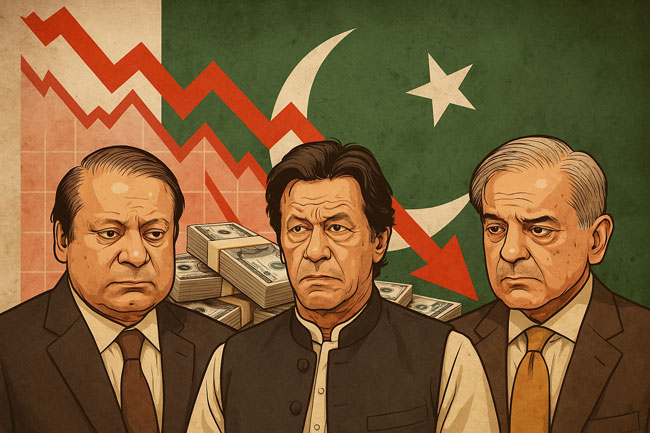Despite the rhetoric and threats of war against India, Pakistan’s internal situation remains extremely weak, as reflected by its economic condition. Today, Pakistan’s debt has increased to such an extent that it may face difficulties managing its economic structure in the event of a war. Here, we will discuss the terms of Prime Ministers Nawaz Sharif, Shehbaz Sharif, and Imran Khan and explore what steps they took under the guise of improving Pakistan’s economy and what the outcomes were.
Pakistan’s Growing Debt
Pakistan carries such a heavy debt today that, in the case of a war, the country may not last more than a week due to its economic crisis. According to global economic data, by December 2024, Pakistan’s external debt is projected to reach about $131 billion, which is nearly 35% of the country’s Gross Domestic Product (GDP). This debt has increased significantly during the leadership of three key figures—Nawaz Sharif, Imran Khan, and Shehbaz Sharif.
Nawaz Sharif’s Tenure (2013-2017)
After Nawaz Sharif became Prime Minister, Pakistan borrowed extensively from several major countries and international organizations. His tenure was economically challenging for Pakistan, particularly due to the debt incurred for the China-Pakistan Economic Corridor (CPEC). During Nawaz Sharif’s time, Pakistan’s total debt rose to $60.6 billion, which included loans from the IMF, China, and other countries. His policies exacerbated the country’s economic crisis, ultimately leading Pakistan to a much higher debt burden on the global stage.
Imran Khan’s Tenure (2018-2022)
Under Imran Khan’s leadership, Pakistan’s economic situation deteriorated further. His government accelerated borrowing, particularly from the IMF and Saudi Arabia. Despite several efforts, Pakistan’s debt surged to $100 billion during his tenure. His administration’s policies, which relied heavily on foreign loans, caused Pakistan’s economy to worsen, leaving the country dependent on external financial assistance.
Shehbaz Sharif’s Tenure (2022-2025)
Shehbaz Sharif’s government introduced several measures to stabilize the country’s debt, but Pakistan still faced a severe economic crisis. After taking office, Shehbaz’s administration saw a further decline in the economy. His government had to bear the burden of the debts accumulated by previous administrations, worsening the economic situation. By the end of Shehbaz Sharif’s term, Pakistan’s debt had reached $131 billion, revealing the country’s deep economic instability.
Conclusion
All three of these major leaders have taken steps under the banner of improving Pakistan’s economy, but their policies have only worsened the situation. Pakistan’s growing debt clearly demonstrates that the country’s economy is incapable of sustaining itself in the event of war or any major crisis. Unless Pakistan adopts solid and sustainable economic policies, it will face even greater challenges in the future.




